Functional Materials and Innovative Strategies for Wearable Thermal Management Applications
- PMID: 37386321
- PMCID: PMC10310690
- DOI: 10.1007/s40820-023-01126-1
Functional Materials and Innovative Strategies for Wearable Thermal Management Applications
Abstract
Highlights:
This article systematically reviews the thermal management wearables with a specific emphasis on materials and strategies to regulate the human body temperature.
Thermal management wearables are subdivided into the active and passive thermal managing methods.
The strength and weakness of each thermal regulatory wearables are discussed in details from the view point of practical usage in real-life.
Abstract:
Thermal management is essential in our body as it affects various bodily functions, ranging from thermal discomfort to serious organ failures, as an example of the worst-case scenario. There have been extensive studies about wearable materials and devices that augment thermoregulatory functionalities in our body, employing diverse materials and systematic approaches to attaining thermal homeostasis. This paper reviews the recent progress of functional materials and devices that contribute to thermoregulatory wearables, particularly emphasizing the strategic methodology to regulate body temperature. There exist several methods to promote personal thermal management in a wearable form. For instance, we can impede heat transfer using a thermally insulating material with extremely low thermal conductivity or directly cool and heat the skin surface. Thus, we classify many studies into two branches, passive and active thermal management modes, which are further subdivided into specific strategies. Apart from discussing the strategies and their mechanisms, we also identify the weaknesses of each strategy and scrutinize its potential direction that studies should follow to make substantial contributions to future thermal regulatory wearable industries.
Keywords: Active heat transfer; Passive heat transfer; Thermal management; Wearable device; Wearable materials.
Conflict of interest statement
The authors declare that they have no known competing financial interests or personal relationships that could have appeared to influence the work reported in this paper.
Figures


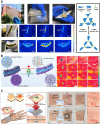
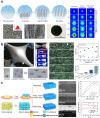


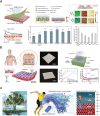
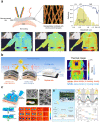


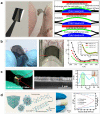
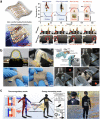
Similar articles
-
Thermal and mechanical characterization of high performance polymer fabrics for applications in wearable devices.Sci Rep. 2021 Apr 22;11(1):8705. doi: 10.1038/s41598-021-87957-7. Sci Rep. 2021. PMID: 33888743 Free PMC article.
-
Polymer and Composite Materials in Two-Phase Passive Thermal Management Systems: A Review.Materials (Basel). 2023 Jan 17;16(3):893. doi: 10.3390/ma16030893. Materials (Basel). 2023. PMID: 36769900 Free PMC article. Review.
-
Thermal management and control of wearable devices.iScience. 2022 Jun 10;25(7):104587. doi: 10.1016/j.isci.2022.104587. eCollection 2022 Jul 15. iScience. 2022. PMID: 35784789 Free PMC article. Review.
-
Janus-Type Hydroxyapatite-Incorporated Kevlar Aerogel@Kevlar Aerogel Supported Phase-Change Material Gel toward Wearable Personal Thermal Management.ACS Appl Mater Interfaces. 2022 Mar 16;14(10):12617-12629. doi: 10.1021/acsami.1c23774. Epub 2022 Mar 2. ACS Appl Mater Interfaces. 2022. PMID: 35235285
-
A Triple-Mode Midinfrared Modulator for Radiative Heat Management of Objects with Various Emissivity.Nano Lett. 2021 May 12;21(9):4106-4114. doi: 10.1021/acs.nanolett.1c01147. Epub 2021 Apr 26. Nano Lett. 2021. PMID: 33899487
Cited by
-
Ultrafast Response and Threshold Adjustable Intelligent Thermoelectric Systems for Next-Generation Self-Powered Remote IoT Fire Warning.Nanomicro Lett. 2024 Jul 10;16(1):242. doi: 10.1007/s40820-024-01453-x. Nanomicro Lett. 2024. PMID: 38985378 Free PMC article.
-
Advances in Biointegrated Wearable and Implantable Optoelectronic Devices for Cardiac Healthcare.Cyborg Bionic Syst. 2024 Oct 18;5:0172. doi: 10.34133/cbsystems.0172. eCollection 2024. Cyborg Bionic Syst. 2024. PMID: 39431246 Free PMC article. Review.
-
A Novel Sandwich-Structured Phase Change Composite with Efficient Photothermal Conversion and Electromagnetic Interference Shielding Interface.Materials (Basel). 2024 Feb 19;17(4):961. doi: 10.3390/ma17040961. Materials (Basel). 2024. PMID: 38399209 Free PMC article.
-
Flexible and Robust Functionalized Boron Nitride/Poly(p-Phenylene Benzobisoxazole) Nanocomposite Paper with High Thermal Conductivity and Outstanding Electrical Insulation.Nanomicro Lett. 2023 Nov 30;16(1):38. doi: 10.1007/s40820-023-01257-5. Nanomicro Lett. 2023. PMID: 38032407 Free PMC article.
-
Engineered Radiative Cooling Systems for Thermal-Regulating and Energy-Saving Applications.Nanomicro Lett. 2025 Aug 5;18(1):21. doi: 10.1007/s40820-025-01859-1. Nanomicro Lett. 2025. PMID: 40762863 Free PMC article. Review.
References
-
- Kaiyala KJ. Energy Homeostasis: Thermoregulation. In: Squire LR, editor. Encyclopedia of Neuroscience. Oxford: Elsevier; 2009. pp. 1043–1052.
-
- E.V. Osilla, J.L. Marsidi, S. Sharma, Physiology, temperature regulation, in: StatPearls [Internet], StatPearls Publishing. - PubMed
-
- Sarbu I. A review on substitution strategy of non-ecological refrigerants from vapour compression-based refrigeration, air-conditioning and heat pump systems. Int. J. Refrig. 2014;46(1):123–141. doi: 10.1016/j.ijrefrig.2014.04.023. - DOI
-
- Brown DR, Stout T, Dirks JA, Fernandez N. The prospects of alternatives to vapor compression technology for space cooling and food refrigeration applications. Energy Eng. 2012;109(6):7–20. doi: 10.1080/01998595.2012.10554226. - DOI
-
- Zhang Q, Xue T, Tian J, Yang Y, Fan W, et al. Polyimide/boron nitride composite aerogel fiber-based phase-changeable textile for intelligent personal thermoregulation. Compos. Sci. Technol. 2022;226(28):109541. doi: 10.1016/j.compscitech.2022.109541. - DOI
Publication types
LinkOut - more resources
Full Text Sources
